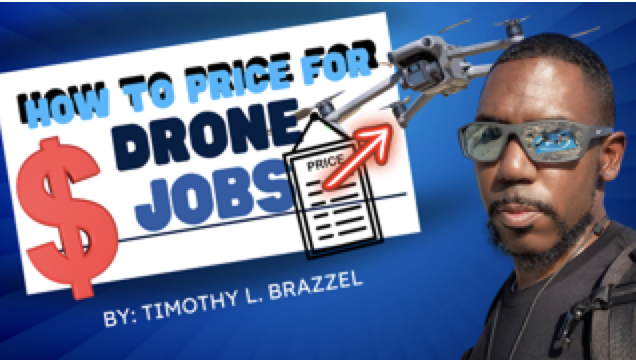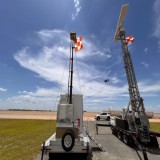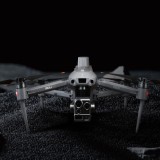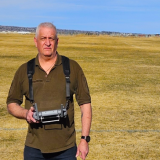
08 November 2023
Determining the appropriate pricing for drone jobs can be a complex decision, especially in the field of professional drone operations. Many certified drone operators struggle with this matter and find it challenging to come up with a figure that is reasonable and respected by clients or businesses. However, I can provide you with some general guidelines on how to determine pricing for drone jobs, and you can adapt this information to your specific situation.
When calculating how much to charge for drone jobs, several factors come into play:
Location: Since I’m based in Southern California, you may charge differently than someone in a less expensive area. Consider the cost of living, competition, and the local market demand.
Experience and Skill Level: Your expertise as a professional videographer can contribute to your pricing. Clients may be willing to pay more for your experience and the quality of your work.
Equipment: Drones come in various models and have different capabilities. The cost of your equipment and any additional camera gear or software will influence your pricing.
Type of Service: The nature of the drone job matters. Are you capturing aerial footage for a real estate listing, creating promotional videos, or filming events for your church? Each type may require different rates.
Time and Labor: Consider the time it takes to plan, set up, fly the drone, and edit the footage. Your hourly rate should cover both the actual flight time and post-production work.
Insurance and Licensing: Ensure that you have the necessary licenses and insurance. These costs should be factored into your pricing.
Market Research: Research competitors in your area and see what they charge for similar drone services. This can help you determine a competitive rate.
Client's Budget: Be aware of your client's budget. Some clients may have a specific budget in mind, while others are more flexible.
Additional Services: Determine if you will offer any additional services like video editing, custom music, or other post-production work, and include those costs.
Travel and Expenses: If the job requires travel, accommodation, or additional expenses, make sure to account for these in your pricing.
It's important to have a transparent pricing structure and communicate this clearly to your clients. You may want to offer different packages based on the scope of the project. Additionally, consider whether you want to charge on a flat fee or hourly basis.
Ultimately, the price you charge for drone jobs should be a balance between covering your costs, making a profit, and providing value to your clients. Don't hesitate to adjust your rates as you gain more experience and build your reputation in the industry.
Create a Transparent Pricing Structure and Communicate it Clearly to Your Clients
Creating a transparent pricing structure for your drone services and effectively communicating it to your clients is crucial for building trust and ensuring that both you and your clients are on the same page. Here's a step-by-step guide on how to achieve this:
Define Your Pricing Model: Decide whether you want to charge on an hourly basis, per project, or offer different packages based on the scope of the job. Consider which model aligns best with your services and clients' needs.
Cost Breakdown: Break down your costs into different components, such as equipment, labor, travel expenses, post-production, and any additional services you offer. This will help clients understand what they're paying for.
Base Rate: Set a base rate that covers your time, expertise, and equipment costs. This can be your starting point for pricing.
Package Options: Offer different package options with clear descriptions of what's included in each. For example, you can have packages for basic aerial footage, premium editing, or extended coverage.
Itemized List: Provide an itemized list of services and their associated costs. This can include things like pre-flight planning, on-site shooting, post-production, and additional add-ons like music licensing or extra editing hours.
Travel Expenses: If travel is involved, be explicit about how travel expenses (e.g., transportation, accommodation, meals) will be handled and billed.
Discounts and Extras: Clearly outline any discounts or extra charges. For instance, you might offer a discount for bundled services or extra fees for rush orders.
Licensing and Insurance: Highlight the importance of your licensing and insurance in ensuring safety and compliance. Assure clients that these factors are included in your pricing.
Payment Terms: Specify your payment terms, including the methods of payment you accept, the payment schedule (e.g., a deposit upfront and final payment upon completion), and any late payment penalties.
Client Consultation: Before providing a quote, have a consultation with your clients to understand their specific needs and expectations. This will help you tailor your pricing to their unique requirements.
Clear Contracts: Draft clear, comprehensive contracts that outline all the terms and conditions, including the pricing structure. Both you and your clients should sign these contracts to ensure everyone is in agreement.
Professional Proposals: Present your pricing structure in professional proposals or quotes. Use software or templates that make it easy to include all the necessary details and present a polished document to your clients.
Discuss Scope Creep: Address the issue of scope creep (additional work beyond the initial agreement) in your contracts and make it clear how additional work will be billed.
Provide Examples: Include examples of past projects and their associated costs to give clients a better understanding of what they can expect.
Open Communication: Encourage open and honest communication with your clients. Be ready to answer their questions and clarify any uncertainties about your pricing.
Review and Update: Periodically review and update your pricing structure to account for changes in your business, equipment upgrades, or market conditions.
Remember that transparency and clear communication are key to a successful client-provider relationship. By following these steps, you can create a pricing structure that clients can easily understand and appreciate.
Potential Challenges
Determining the pricing for drone jobs can indeed be challenging due to various factors and considerations. Here are some potential challenges you may face when trying to figure out how to price drone jobs:
Market Variability: The market for drone services can be highly variable. Prices may fluctuate depending on location, demand, and competition. It can be challenging to determine the right pricing strategy in such a dynamic environment.
Lack of Industry Standards: Unlike some industries with established pricing standards, the drone services industry doesn't have universally recognized pricing guidelines. This lack of standards can make it difficult to set competitive rates.
Diverse Services: Drone services can encompass a wide range of applications, from real estate photography to aerial surveys to videography. Pricing may differ significantly depending on the type of service, which makes it challenging to create a one-size-fits-all pricing structure.
Equipment Costs: Drones and their accompanying equipment can be expensive. You need to factor in the initial purchase cost, maintenance, and upgrades. Balancing these costs with your pricing can be a challenge.
Skill and Experience: Pricing may need to reflect your skill level and experience as a drone pilot and videographer. Clients may be willing to pay more for seasoned professionals.
Regulations and Licensing: Complying with drone regulations, including obtaining the necessary licenses, can be costly and time-consuming. These legal requirements can impact pricing.
Client Budget Constraints: Clients may have budget limitations, and balancing their financial constraints with your desired pricing can be tricky. It's important to find a middle ground that provides value for both you and your clients.
Project Complexity: More complex projects, such as those requiring special permissions, additional safety measures, or unique equipment, may warrant higher pricing. However, accurately assessing the complexity of a project can be challenging.
Competitive Analysis: Researching and understanding your competition can be time-consuming, but it's essential. Overpricing can lead to losing clients, while underpricing can harm your profitability.
Negotiation: Some clients may expect or request discounts or customized pricing. Managing negotiation while maintaining a fair rate for your services can be a challenge.
Changing Technology: The drone industry is continuously evolving with new technology and features. Staying current with these advancements and integrating them into your services can be costly and affect pricing.
Unexpected Costs: Unforeseen expenses can arise during projects, such as equipment repairs or unfavorable weather conditions. Determining how to incorporate these costs into your pricing can be difficult.
Ethical Pricing: Pricing too high can deter potential clients, while pricing too low can undervalue your services and the industry as a whole. Striking the right balance can be challenging.
Payment Collection: Managing the collection of payments and handling clients who are slow to pay or dispute charges can be stressful and impact your cash flow.
Transparency: Communicating your pricing clearly and transparently to clients is essential but can be difficult, especially if clients have diverse needs and preferences.
To navigate these challenges, it's important to conduct thorough market research, consider your costs and desired profit margins, and be willing to adapt your pricing as your experience and the market change. Regularly reviewing and adjusting your pricing structure can help you stay competitive and ensure your business remains profitable.
It is my hope that every reader who reads this blog post finds it helpful and useful information that can be applied to every drone business.
Watch & Learn
More Content By Timothy Brazzel
https://www.thedroningcompany.com/blog/drone-jobs-near-me
https://www.thedroningcompany.com/blog/timothy-brazzel-takes-you-on-a-drone-roof-inspection
https://www.thedroningcompany.com/blog/-timothy-brazzel-s-drone-journey
https://www.thedroningcompany.com/blog/drone-dialog-timothy-brazzel










